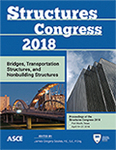Structures Congress 2018
Automating Refined Load Ratings for Girder Bridges
Publication: Structures Congress 2018: Bridges, Transportation Structures, and Nonbuilding Structures
ABSTRACT
Current industry trends in bridge load ratings acknowledge both the benefits of refined ratings and the added expense. Refined ratings are used sparingly in part because of the added level of resources needed produce and evaluate analytical models. This additional effort consists of critical broad engineering decisions such as selecting a modeling approach as well as more specific and laborious tasks like manipulating a finite element analysis program via a graphical user interface (GUI) to build and analyze a model. By separating the broad engineering decisions and passing them as input into a series of automated algorithms that carry out model building, analysis, and results extraction, the refined rating process can be made much more efficient and consistent. The biggest challenge of automating this process is balancing the flexibility and robustness of the process with the amount of engineering effort required to develop the necessary input. The objective of this paper is to demonstrate the value that an automated approach can bring to a refined load rating. Automation also makes a process completely repeatable and more transparent than traditional refined analysis. This paper discusses the refined rating process, as well as the challenges and benefits of automating this process for multi-girder bridges.
Get full access to this article
View all available purchase options and get full access to this chapter.
REFERENCES
AASHTO (American Association of State Highway and Transportation Officials) (2011) The Manual for Bridge Evaluation, 2nd Edition, with 2011, 2013, 2014 and 2015 Interim Revisions. American Association of State Highway and Transportation Officials, 2011.
AASHTO (American Association of State Highway and Transportation Officials) (2014) AASHTO LRFD Bridge Design Specifications, U.S. Customary Units (7th Edition) with 2015 Interim Revisions, Washington, D.C., American Association of State Highway and Transportation Officials.
Bell, E. S., Lefebvre, P. J., Sanayei, M., Brenner, B., Sipple, J. D., and Peddle, J. (2013). "Objective Load Rating of a Steel-Girder Bridge Using Structural Modeling and Health Monitoring." Journal of Structural Engineering, 139(10), 1771-1779.
Breña, S., Jeffrey, A., and Civjan, S. (2013). "Evaluation of a Noncomposite Steel Girder Bridge through Live-Load Field Testing." Journal of Bridge Engineering, 18(7), 690-699.
Chajes, M. J., and Shenton III, H. W. (2005). “Using Diagnostic Load Tests for Accurate Load Rating of Typical Bridges.” Structures Congress 2005 Metropolis and Beyond; 1-11; American Society of Civil Engineers Reston, VA.
FHWA (U.S. Department of Transportation Federal Highway Administration) (2015) Manual of Refined Analysis Draft <https://www.fhwa.dot.gov/bridge/refined_analysis.pdf> (3/29/2016)
Hearn, G. (2014). NCHRP Synthesis 453: State bridge load posting processes and practices. Washington, D.C., Transportation Research Board.
Hodson, D. J., Barr, P. J., and Pockels, L. (2013). “Live-Load Test Comparison and Load Ratings of a Posttensioned Box Girder Bridge.” Journal of Performance of Constructed Facilities. 27(5), 585-593.
Klaiber, F. W., Wipf, T. J., and Russo, F. M. (2004). NCHRP Synthesis 327: Cost-effective practices for off-system and local interest bridges. Washington, D.C., Transportation Research Board.
Krzmarzick, D. P. and J. F. Hajjar (2006). “Load Rating of Curved Composite Steel I-Girder Bridges through Load Testing with Heavy Trucks.” Structures Congress 2006 Structural Engineering and Public Safety; 1-10; American Society of Civil Engineers Reston, VA
Mabsout, M. E., et al. (1997). "Finite-Element Analysis of Steel Girder Highway Bridges." Journal of Bridge Engineering 2(3): 83-87.
PennDOT (Pennsylvania Department of Transportation) (2016) User's Manual For Computer Program STLRFD: LRFD Steel Girder Design And Rating Version 2.4.0.0, Prepared by Michael Baker International for Pennsylvania Department of Transportation, 2016
Python Software Foundation (2017). Python Language Reference, Version 2.7. <http://www.python.org> (6/23/2017).
Sanayei, M., et al. (2012). "Instrumentation, Nondestructive Testing, and Finite-Element Model Updating for Bridge Evaluation Using Strain Measurements." Journal of Bridge Engineering 17(1): 130-138.
Scoggins, Luke A. (2008), “3-D Finite Element Modeling in OpenSees for Bridge Live-Load Girder Distribution Factors” (Masters Thesis), Oregon State University.
Strand7 (2014) Strand7 Software, API Manual: Documentation for the Strand7 Application Programming Interface. Release 2.4.6, Sydney Australia, 2014.
White, D. W. (2012). NCHRP Report 725: Guidelines for analysis methods and construction engineering of curved and skewed steel girder bridges. Washington, D.C, Transportation Research Board.
Zhou, Y., Prader, J., Weidner, J., Dubbs, N., Moon, F., and Aktan, A. (2012). "Structural Identification of a Deteriorated Reinforced Concrete Bridge." Journal of Bridge Engineering, 17(5), 774-787.
Information & Authors
Information
Published In
Structures Congress 2018: Bridges, Transportation Structures, and Nonbuilding Structures
Pages: 261 - 274
Editor: James Gregory Soules, CB&I
ISBN (Online): 978-0-7844-8133-2
Copyright
© 2018 American Society of Civil Engineers.
History
Published online: Apr 17, 2018
Published in print: Apr 17, 2018
Authors
Metrics & Citations
Metrics
Citations
Download citation
If you have the appropriate software installed, you can download article citation data to the citation manager of your choice. Simply select your manager software from the list below and click Download.
